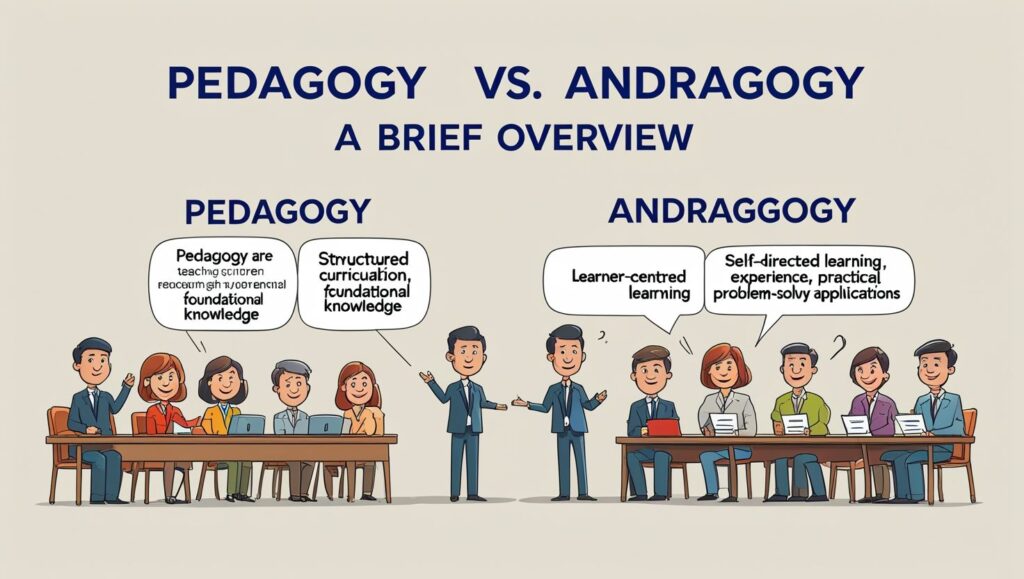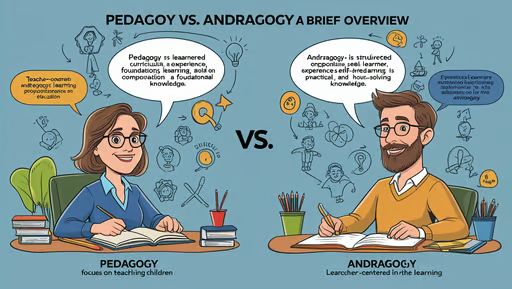Introduction
Pedagogy vs. Andragogy in Education, Education is a dynamic field that continuously evolves to meet the needs of learners across different stages of life. Two key concepts that have shaped educational practices are pedagogy and andragogy. While both approaches focus on facilitating learning, they differ significantly in their assumptions, methods, and applications. Pedagogy is traditionally associated with teaching children, while andragogy is tailored to adult learners. This article explores the distinctions between pedagogy and andragogy, their theoretical foundations, and their implications for modern education.
What is Pedagogy?
Pedagogy, derived from the Greek words paidos (child) and agogos (leader), refers to the art and science of teaching children. It is a teacher-centered approach where the instructor assumes full responsibility for what is taught, how it is taught, and when it is taught. Pedagogical methods rooted in the idea that children are dependent learners who rely on the teacher for guidance, structure, and knowledge.
Key Characteristics of Pedagogy
- Teacher-Centered Learning: The teacher is the primary authority figure, directing the learning process and making decisions about the curriculum and instructional methods.
- Dependence on the Teacher: Students are seen as passive recipients of knowledge, relying on the teacher to provide information and evaluate their progress.
- Structured Curriculum: Learning highly structured, with a fixed syllabus, standardized assessments, and a focus on foundational knowledge.
- External Motivation: Children often motivated by external factors such as grades, rewards, or fear of punishment.
- Limited Life Experience: Since children have limited life experience, the teacher plays a crucial role in shaping their understanding of the world.
Pedagogy has been the dominant approach in primary and secondary education for centuries. It emphasizes discipline, repetition, and memorization, which are considered essential for building a strong educational foundation.
What is Andragogy?
Andragogy, coined by Malcolm Knowles in the 1960s, is the theory and practice of educating adults. The term comes from the Greek words andros (man) and agogos (leader), reflecting its focus on adult learning. Unlike pedagogy, andragogy is a learner-centered approach that recognizes the unique characteristics and needs of adult learners.
Key Characteristics of Andragogy
- Self-Directed Learning: Adults are seen as autonomous learners who take responsibility for their own learning. They set their own goals, choose learning methods, and evaluate their progress.
- Experience-Based Learning: Adults bring a wealth of life experiences to the learning process, which serves as a valuable resource for new learning.
- Problem-Centered Approach: Adult learners motivated by practical, real-world problems. They prefer learning that is immediately applicable to their personal or professional lives.
- Internal Motivation: Adults are driven by intrinsic factors such as personal growth, career advancement, or the desire to solve specific problems.
- Flexible Curriculum: Andragogy emphasizes flexibility, allowing learners to tailor their learning experiences to their individual needs and interests.
Andragogy has gained prominence in higher education, corporate training, and lifelong learning programs. It acknowledges that adults learn differently from children and require a more collaborative and experiential approach.
Key Differences Between Pedagogy and Andragogy
While both pedagogy and andragogy aim to facilitate learning, they differ in several fundamental ways:
- Learner Role:
- Pedagogy: Learners are dependent on the teacher for guidance and direction.
- Andragogy: Learners are self-directed and take an active role in their education.
- Learning Motivation:
- Pedagogy: Motivation is often external, driven by grades, rewards, or parental expectations.
- Andragogy: Motivation is internal, driven by personal goals, career advancement, or problem-solving.
- Role of Experience:
- Pedagogy: Learners have limited life experience, so the teacher provides the necessary context.
- Andragogy: Learners bring rich life experiences, which integrated into the learning process.
- Learning Focus:
- Pedagogy: Focuses on acquiring foundational knowledge and skills.
- Andragogy: Focuses on solving real-world problems and applying knowledge in practical contexts.
- Curriculum Design:
- Pedagogy: Follows a structured, standardized curriculum.
- Andragogy: Emphasizes flexibility and customization to meet individual learner needs.

Implications for Modern Education
Understanding the differences between pedagogy and andragogy has significant implications for educators, curriculum designers, and policymakers. Here are some key considerations:
1. Adapting Teaching Methods
Educators must recognize that one size does not fit all. While pedagogical methods are effective for children, they may not resonate with adult learners. For example, a lecture-based approach might work well in a high school classroom but could disengage adult learners who prefer interactive, problem-based learning.
2. Lifelong Learning
The concept of lifelong learning has gained traction in today’s fast-paced, knowledge-driven world. Andragogy plays a crucial role in supporting adult learners who seek to upskill, reskill, or pursue personal interests. Educational institutions and employers must create flexible, accessible learning opportunities that align with the principles of andragogy.
3. Technology Integration
Technology has transformed the way we learn, offering new opportunities for both pedagogy and andragogy. For children, educational apps and gamified learning platforms can make learning more engaging. For adults, online courses, webinars, and virtual collaboration tools provide the flexibility needed to balance learning with other responsibilities.
4. Professional Development
Andragogy is particularly relevant in the context of professional development. Employers must design training programs that align with the needs and motivations of adult learners. This includes offering hands-on experiences, opportunities for reflection, and clear connections between learning and career advancement.
5. Bridging the Gap
While pedagogy and andragogy are often seen as distinct approaches, there is a growing recognition of the need to bridge the gap between them. For example, older adolescents and young adults may benefit from a blend of pedagogical and andragogical methods as they transition from dependent to independent learners.
Challenges and Criticisms
Both pedagogy and andragogy have their limitations. Critics of pedagogy argue that its teacher-centered approach can stifle creativity and critical thinking, while critics of andragogy suggest that it may overlook the diverse needs of adult learners, particularly those with limited prior education or self-directed learning skills.
Additionally, the rigid distinction between pedagogy and andragogy has been questioned. Some educators advocate for a more holistic approach that considers the unique needs of each learner, regardless of age. This has led to the emergence of concepts like heutagogy, which emphasizes self-determined learning and is applicable to learners of all ages.
Conclusion
Pedagogy and andragogy represent two distinct approaches to education, each with its own strengths and limitations. Pedagogy well-suited for teaching children, providing the structure and guidance they need to build foundational knowledge. Andragogy, on the other hand, empowers adult learners by recognizing their autonomy, experience, and practical motivations.
As the field of education continues to evolve, it is essential for educators to understand and apply the principles of both pedagogy and andragogy. By doing so, they can create inclusive, effective learning environments that cater to the diverse needs of learners across all stages of life. Ultimately, the goal of education is to foster a lifelong love of learning, and both pedagogy and andragogy have a vital role to play in achieving this objective.

8 thoughts on “Pedagogy vs. Andragogy in Education”
Comments are closed.